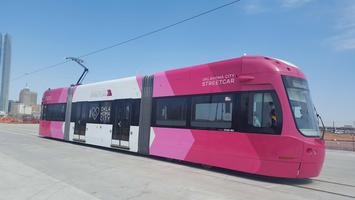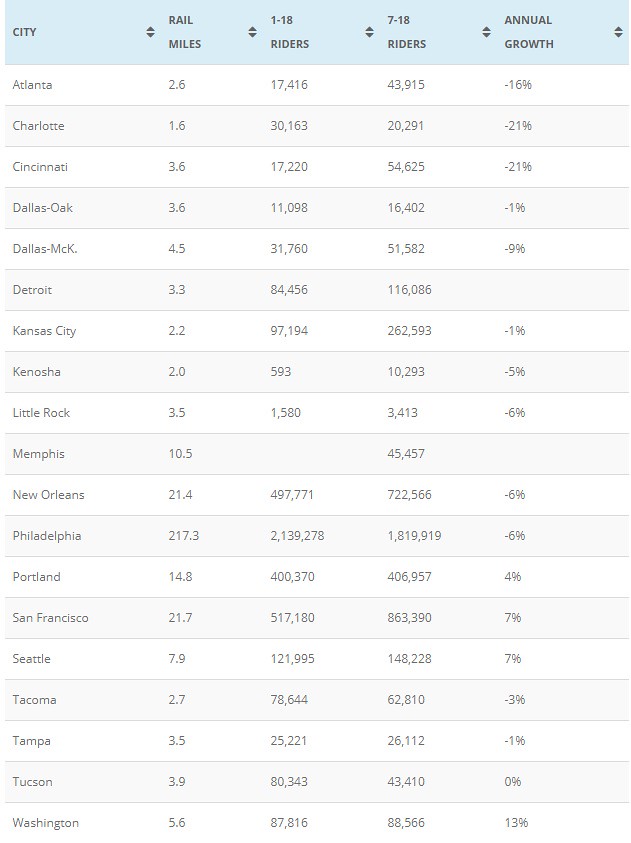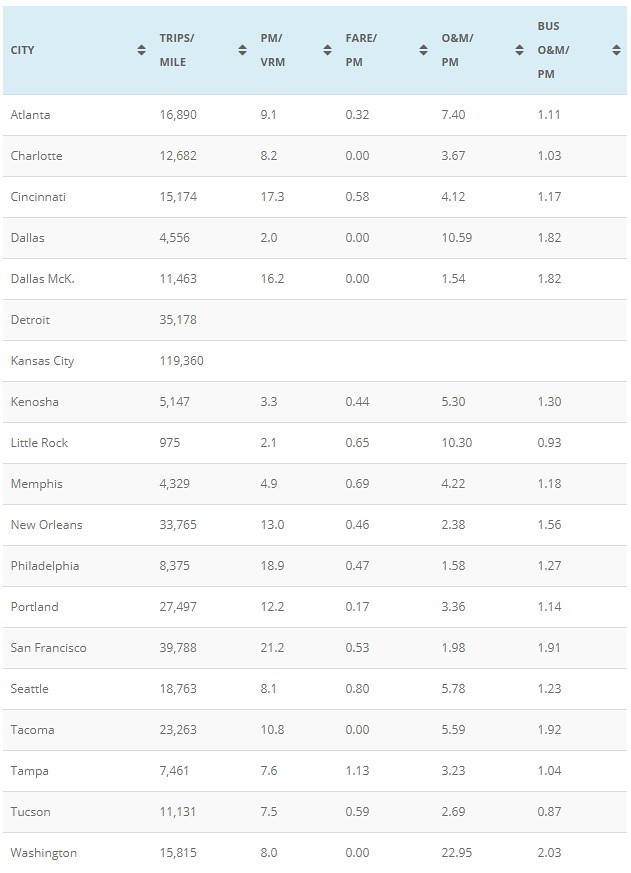
Milwaukee and Oklahoma City are both planning to open new streetcar lines later this year, so it is worth taking a look at how the dumbest form of transit is working in other cities. The table below shows all of the streetcar lines reported in the July, 2018 National Transit Database spreadsheet. Ridership numbers are shown for January and July and annual growth compares the last full year (August 2017-July 2018) with the year before that.

The table below provides some indicators of productivity: trips per mile (based on July, 2018 ridership), occupancy (passenger miles per vehicle revenue mile), fares per passenger mile, and operations & maintenance costs per passenger mile. For comparison purposes, bus costs per passenger mile are shown for the dominant bus system in the same city. Occupancies, fares, and costs are based on 2016 data except for Memphis, whose streetcar was closed for maintenance from July 2014 through March 2018 and so uses 2014 data. No fare or cost data are available for Detroit or Kansas City but they should be included in the 2017 National Transit Database later this year.

I consider the Philadelphia trolleys to be light rail, but the FTA calls them streetcars, so I’ve included them here for the sake of comparison. Like Philadelphia’s, New Orleans and San Francisco streetcars are legacy systems that have been continuously operating for more than a century. All of the other systems are effectively new even if they use vintage vehicles. Dallas has two streetcar lines, Oak Cliff and McKinney Avenue. Salt Lake City has a streetcar line but it doesn’t appear in the database.
Note that some lines, such as Atlanta, Cincinnati, and Kenosha, are highly seasonal, with much higher ridership in July than in January. This suggests these are mainly used by tourists rather than local residents. Tucson’s riders seem to prefer winter over summer.
In most cases, ridership of the newer lines is well below projections. For example, the Cincinnati line was expected to attract around 85,000 riders a month, but in the last year the average has been under 44,000. Streetcar advocates offer flimsy excuses for these shortfalls. “The original projections for ridership were made by a consultant in 2011, before construction was even really underway,” says a spokesperson for the Cincinnati streetcar. But that’s the projection the city relied on when it committed itself to spend more than $100 million on the project.
The number of trips carried per rail mile is a good indication of a line’s productivity. Downtown streetcar lines with fewer than 10,000 trips per mile, including those in Dallas-Oak Cliff, Kenosha, Little Rock, Memphis, and Tampa, are extremely unproductive. Philadelphia’s trolleys also carry fewer than 10,000 trips per mile, but that’s because they are not downtown lines but move commuters from suburbs to the city and are relatively empty at the suburban ends of the lines.
The standard for other cities should be San Francisco’s, which carry nearly 40,000 trips per mile. New Orleans is also pretty high. I don’t get the numbers for Kansas City; either something is wrong with the data or that system is somehow spectacularly outperforming every other streetcar line in the country. The 2017 data might clear this up.
Occupancies are another indicator of productivity. Most modern streetcars have 30 seats and lots of standing room; vintage streetcars tend to have around 60 seats. Again, San Francisco is the standard, carrying an average of more than 20 riders. Lines that carry less than 10 are pretty unproductive.
At least six cities are still uncertain enough about their riders that they aren’t charging fares. Detroit is charging fares but Kansas City is not. If Kansas City’s line is as productive as the trips per mile indicate, why aren’t they charging a fare? Of course, even in the cities that charge fares, the revenues don’t begin to cover the operations & maintenance costs.
The biggest indictment against the streetcars is that they cost so much more to operate than buses. Dallas’ McKinney Avenue streetcar costs less than buses and San Francisco’s streetcar is about the same as buses, but that mainly because buses in those two cities are pretty inefficient as they cost close to $2 per passenger mile compared to around $1 in most other cities.
If it were up to me, I would immediately replace all of these systems with buses except for those in Philadelphia, San Francisco, the McKinney Avenue streetcar in Dallas, and possibly New Orleans. Kansas City is an open question whose answer will depend on 2017 data. If local businesses protested, I would create a tax district consisting of all areas within one block of a streetcar stop and make them pay, either through property or sales taxes, for 100 percent of the operating losses. This tax would be on top of other taxes paid by the property owners, and not be offset by a reduction in other taxes the way tax-increment financing works. I certainly wouldn’t spend any more federal dollars on these lines.
Unfortunately, it isn’t up to me. The FTA recently made $99 million available to a planned streetcar line in Santa Ana and Garden Grove (Orange County), California. Washington insiders say it is better to spend money on projects like these than on the New York Gateway Project, which if built could ultimately cost taxpayers tens of billions of dollars. But it would be nice not to waste any money at all.
This piece first appeared on The Antiplanner.
Randal O’Toole is a senior fellow with the Cato Institute specializing in land use and transportation policy. He has written several books demonstrating the futility of government planning. Prior to working for Cato, he taught environmental economics at Yale, UC Berkeley, and Utah State University.
Photo via Oklahoma City Streetcar.













Loss leaders
So I generally agree that streetcars (like mass transit generally) are mostly a waste of money. This article explains why.
But in a few cases the systems serve non-transit ends, namely they are tourist attractions. SF's cable cars are likely the best example, but the streetcar (named Desire) in New Orleans can't be far behind. I actually rode the street car in Tampa--I was a tourist and it was free. Obviously if I actually lived in Tampa I'd never use it at all.
I call it the Staten Island Ferry effect. That's such a wonderful tourist attraction that it would be counterproductive to start charging money for it. It undoubtedly earns its keep from all the foreign tourists patronizing NYC hotels, restaurants, and stores.